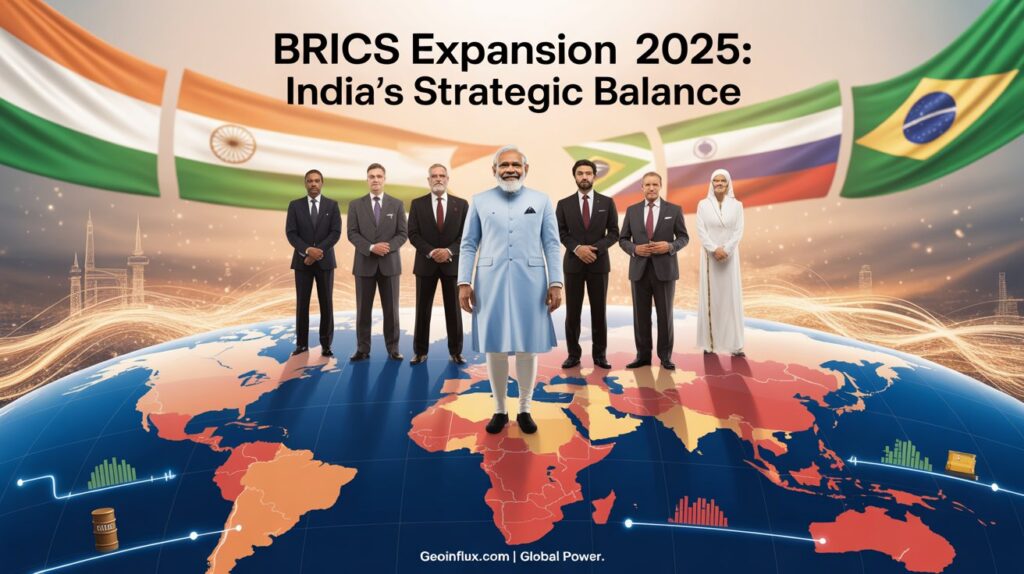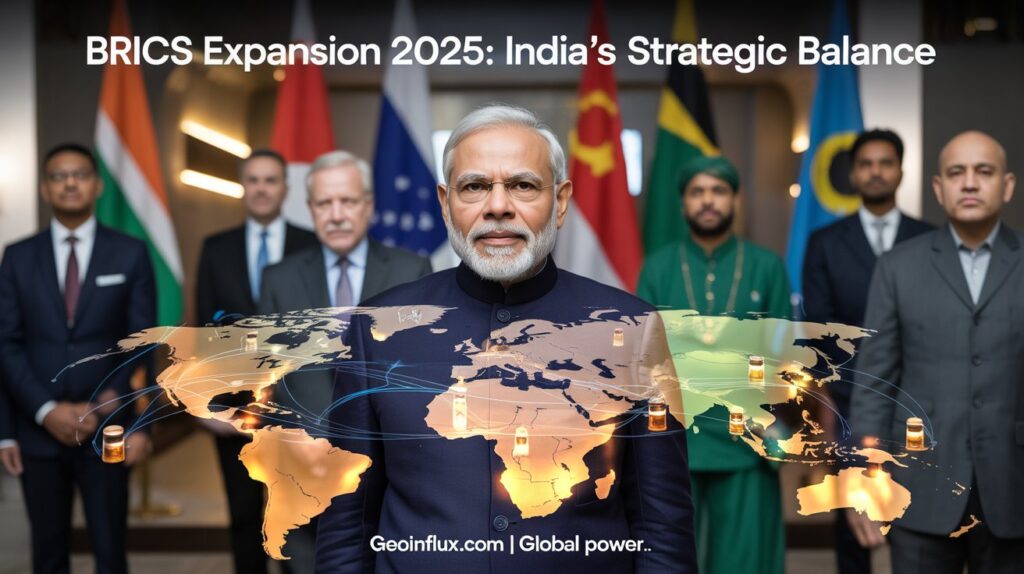Explore how the BRICS expansion 2025 impacts India’s diplomacy, trade, and strategic autonomy amid China’s growing influence and global multipolar realignment.
🔍 What Does BRICS Expansion 2025 Mean for India?
The BRICS expansion 2025 marks a major geopolitical shift — with nations like Saudi Arabia, Iran, Egypt, Argentina, and the UAE joining the original bloc of Brazil, Russia, India, China, and South Africa.
For India, this expansion presents both opportunities and complexities.
Also Read: India’s Foreign Policy in a Multipolar World
While the bloc’s growth signals the emergence of a multipolar economic order, it also raises questions about China’s influence, the role of the Global South, and whether India can preserve its strategic autonomy amid competing interests.

This article breaks down India’s strategic balancing act within the expanded BRICS, examining the trade, energy, and diplomatic equations that will shape 2025 and beyond.
🌍 What Is Driving the BRICS Expansion 2025?
The BRICS expansion 2025 was driven by three critical global dynamics:
- Western economic fatigue and dollar dependency pushback
- The Russia–Ukraine war is accelerating South-South cooperation
- China’s bid to institutionalise a multipolar financial structure
For India, these changes open doors to de-dollarisation, new trade routes, and energy security — but also come with geopolitical friction, especially regarding China’s dominance within BRICS.
India’s stance: Expansion is welcome, but governance and consensus must remain balanced — not China-centric.
⚖️ How Is India Managing China’s Dominance in BRICS Expansion 2025?
India’s primary concern is ensuring that BRICS doesn’t become a proxy for China’s geopolitical agenda.
Beijing’s push for rapid inclusion of nations aligned with its Belt and Road Initiative (BRI) tested New Delhi’s diplomatic patience.
India’s Balancing Measures:
- Advocated for consensus-based decision-making
- Insisted on non-alignment of BRICS with any anti-West bloc
- Proposed an equal representation system for all members
By doing so, India reaffirmed its identity as a bridge power — aligning with neither the West nor China fully but leveraging both sides for strategic gain.
🛢️ How Is BRICS Expansion Impacting India’s Energy Security?
The inclusion of energy giants like Saudi Arabia, the UAE, and Iran gives BRICS a new economic weight.
For India, which imports over 80% of its crude oil, this expansion directly strengthens its energy diplomacy.
Strategic Benefits:
- Discounted oil and gas trade through BRICS payment mechanisms
- Reduced dependency on the US dollar for transactions
- Diversified suppliers across Asia, the Middle East, and Africa
However, tensions persist as Russia–China energy coordination sometimes sidelines India’s preferences.
Still, the BRICS oil trade framework could evolve into a non-Western energy corridor, aligning with India’s vision of energy independence by 2030.
💱 Can BRICS Expansion Reshape Global Trade for India?
India’s trade volume within BRICS is expected to grow by 25–30% in the next three years post-expansion.
The creation of a BRICS Development Bank (NDB) in local currencies supports India’s Atmanirbhar Bharat initiative by boosting rupee-based settlements.
Trade Highlights:
- New BRICS payment system could rival SWIFT
- Expanded access to African and Latin American markets
- Stronger supply chains outside Western-dominated structures
India’s challenge: balancing economic pragmatism with strategic caution to avoid overreliance on Chinese-led trade platforms.
🪙 Is the BRICS Currency a Threat or Opportunity for India?
The proposed BRICS reserve currency, potentially backed by gold and energy commodities, is a bold alternative to the dollar.
While India supports currency diversification, it remains cautious.
India’s Perspective:
- Favours bilateral trade in local currencies (like with Russia)
- Opposes a China-controlled digital BRICS currency
- Prioritises sovereign monetary autonomy
In essence, India’s position is to participate without surrendering control, ensuring that any monetary innovation benefits all equally.
🤝 How Is BRICS Expansion 2025 Affecting India’s Global Alliances?
India’s participation in BRICS complements its role in other forums like the QUAD, G20, and SCO.
Despite Western scepticism, New Delhi uses its presence to advocate for Global South issues—debt reform, climate equity, and equitable trade.
Strategic Duality:
- BRICS with Russia and China for multipolarity
- QUAD with the US and Japan for Indo-Pacific stability
This dual-track diplomacy defines India’s foreign policy maturity in the 2020s: assertive, autonomous, and adaptive.
🧠 What Are the Strategic Risks for India in BRICS Expansion 2025?
- Overconcentration of power by China and Russia
- Institutional imbalance in the representation of new members
- Diverging national interests on sanctions, tech, and defence
- Western pushback on India’s participation in “anti-dollar” talks
Yet, India’s steady diplomacy prevents escalation, maintaining its trusted partner image across both blocs.
🔮 Strategic Takeaways: India’s Path in the New BRICS Order
- Balanced multipolar engagement is India’s core strategy.
- Economic pragmatism trumps ideology — trade over alignment.
- Energy and tech sovereignty are key post-expansion priorities.
- India’s influence hinges on maintaining consensus-based mechanisms within BRICS.
The BRICS expansion 2025 India strategy thus exemplifies a mature foreign policy that thrives amid complexity — neither anti-West nor China-centric, but confidently multipolar.
📊 Recap: BRICS Expansion 2025 Impact on India
| Domain | Opportunity | Challenge |
|---|---|---|
| Trade | Policy friction with the West | Chinese overreach |
| Energy | Discounted oil, diversified suppliers | Policy friction with West |
| Finance | BRICS currency initiatives | Monetary sovereignty risk |
| Diplomacy | Voice of Global South | Balancing East-West ties |
❓ FAQs on BRICS Expansion 2025 India
Q1. What is BRICS Expansion 2025?
It’s the enlargement of BRICS to include Saudi Arabia, Iran, Egypt, UAE, and Argentina — reshaping the bloc’s economic power.
Q2. Why is BRICS Expansion important for India?
It boosts India’s access to energy, trade, and South-South cooperation while showcasing leadership in the Global South.
Q3. Does BRICS Expansion 2025 challenge the West?
Yes, but indirectly — it offers alternatives to Western-led systems without confrontation.
Q4. How does India balance BRICS and QUAD?
By pursuing multi-alignment, focusing on cooperation in both blocs without choosing sides.
Q5. Will India support a BRICS common currency?
Cautiously. India supports local currency trade but avoids dependency on a China-dominated mechanism.
🔗 Related Articles from GeoInflux
- India–Russia Trade in a Sanctioned World
- India and the QUAD Strategy Explained
- Strategic Autonomy in a Multipolar World
📚 References:
- MEA India – BRICS Chairmanship Portal
- The Diplomat – India’s Role in BRICS Expansion
- Brookings – The Future of BRICS and Global South Politics
- Reuters – BRICS 2025 Summit Coverage
- ORF – Strategic Autonomy in BRICS Era





